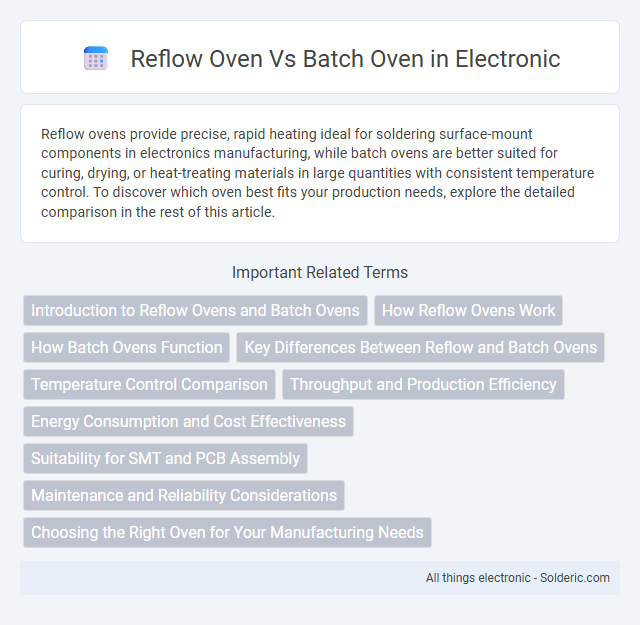Reflow ovens provide precise, rapid heating ideal for soldering surface-mount components in electronics manufacturing, while batch ovens are better suited for curing, drying, or heat-treating materials in large quantities with consistent temperature control. To discover which oven best fits your production needs, explore the detailed comparison in the rest of this article.
Comparison Table
| Feature | Reflow Oven | Batch Oven |
|---|---|---|
| Process Type | Continuous conveyor-based heating | Single or multiple trays heated simultaneously |
| Primary Use | Soldering surface mount components in PCB assembly | Curing, drying, or baking components and materials |
| Heating Method | Controlled zone heating with convection and radiation | Uniform heating in static chamber |
| Throughput | High, suitable for mass production | Lower, suited for small batches or varied products |
| Temperature Control | Precise profile control for temperature ramp and soak | Stable temperature, less dynamic control |
| Typical Industries | Electronics manufacturing, PCB assembly | Pharmaceutical, chemical, electronics, automotive |
| Cost | Higher initial cost, efficient for long runs | Lower initial cost, flexible for different batch sizes |
| Space Requirement | Footprint varies, usually larger footprint | Compact, flexible footprint |
Introduction to Reflow Ovens and Batch Ovens
Reflow ovens use precise temperature-controlled zones to solder electronic components onto printed circuit boards by melting solder paste in a continuous conveyorized process. Batch ovens operate by heating entire batches of components or assemblies simultaneously within a single chamber, offering uniform thermal profiles ideal for curing or drying applications. Your choice between reflow and batch ovens depends on production volume, thermal requirements, and process consistency.
How Reflow Ovens Work
Reflow ovens use precise, controlled heat zones to gradually increase and decrease the temperature, allowing solder paste on electronic components to melt and solidify for reliable circuit board assembly. This continuous conveyor system moves printed circuit boards through multiple temperature phases, including preheat, soak, reflow, and cooling, ensuring uniform solder joint quality and minimal thermal stress. You benefit from faster processing times and higher throughput compared to batch ovens, which heat components in fixed chambers and rely on slower thermal cycles.
How Batch Ovens Function
Batch ovens operate by processing materials in discrete loads within a sealed chamber, allowing precise temperature control for each batch. This method ensures uniform heating through convection or conduction, making them ideal for curing, drying, or baking sensitive components. Your production benefits from flexibility in processing varying quantities without continuous operation.
Key Differences Between Reflow and Batch Ovens
Reflow ovens use conveyor belts to heat and cool PCBs continuously, enabling rapid and uniform soldering, while batch ovens process multiple boards simultaneously in a sealed chamber with controlled heating cycles. The key differences lie in throughput, temperature consistency, and production scale, with reflow ovens favored for high-volume, precise surface-mount assembly and batch ovens suited for lower volumes or larger components. Your choice depends on production speed, board complexity, and process control requirements.
Temperature Control Comparison
Reflow ovens offer precise temperature control with programmable heating zones that ensure consistent soldering profiles, making them ideal for surface mount technology (SMT) applications. Batch ovens, in contrast, typically provide less granular temperature control, relying on chamber-wide heat that can result in uneven thermal distribution and potential component stress. Your manufacturing process benefits from selecting a reflow oven when precise temperature regulation is critical for quality and repeatability.
Throughput and Production Efficiency
Reflow ovens provide higher throughput by enabling continuous processing of printed circuit boards, which significantly reduces cycle times compared to batch ovens. Batch ovens operate on a fixed load that must complete the entire temperature profile before the next batch begins, resulting in lower production efficiency and longer turnaround times. Optimizing your production line with a reflow oven can maximize output and enhance overall efficiency for high-volume manufacturing.
Energy Consumption and Cost Effectiveness
Reflow ovens typically consume less energy due to their precise temperature control and shorter processing times, making them cost-effective for high-volume electronics manufacturing. Batch ovens, while capable of handling larger loads, often require longer heating cycles and maintain higher ambient temperatures, resulting in increased energy consumption. Choosing a reflow oven can reduce operational costs and enhance energy efficiency in surface-mount technology (SMT) production lines.
Suitability for SMT and PCB Assembly
Reflow ovens are ideal for SMT and PCB assembly due to their precise temperature control and consistent heat distribution, which ensure reliable soldering of surface mount components. Batch ovens, while capable of handling larger volumes, offer less uniform temperature profiles, making them less suitable for delicate SMT processes. Your choice depends on the production scale and the need for uniform soldering quality in PCB assembly.
Maintenance and Reliability Considerations
Reflow ovens require regular maintenance of their conveyor belts and heating elements to ensure consistent temperature profiles, which directly impacts soldering quality and reliability. Batch ovens, while simpler in design, demand routine checks on chamber seals and uniform heating to avoid thermal gradients that could compromise product integrity. Understanding these maintenance requirements helps you optimize uptime and extend the lifespan of your soldering equipment.
Choosing the Right Oven for Your Manufacturing Needs
Selecting the right oven for manufacturing depends on production volume and thermal process requirements. Reflow ovens offer precise temperature control and continuous conveyor systems ideal for high-volume, automated PCB soldering. Batch ovens provide flexibility for smaller runs and diverse applications, allowing centralized temperature uniformity for curing, drying, or baking in controlled environments.
Reflow oven vs batch oven Infographic

 solderic.com
solderic.com